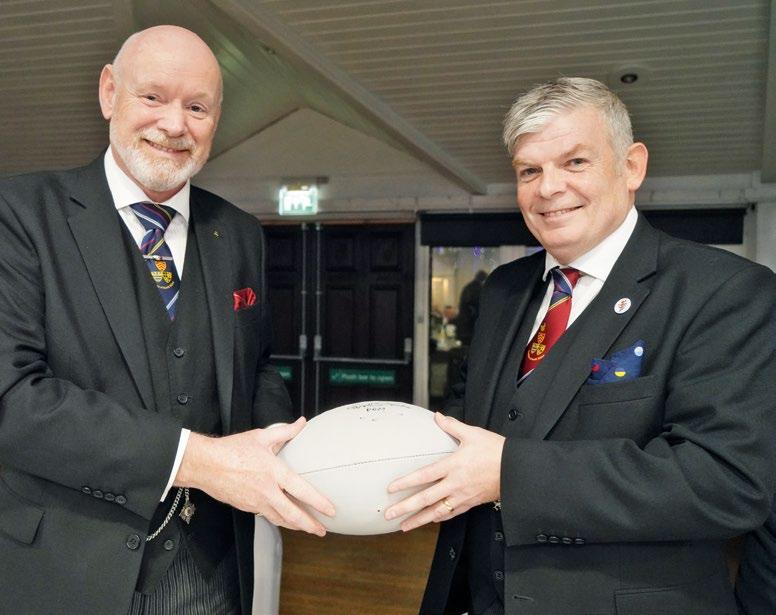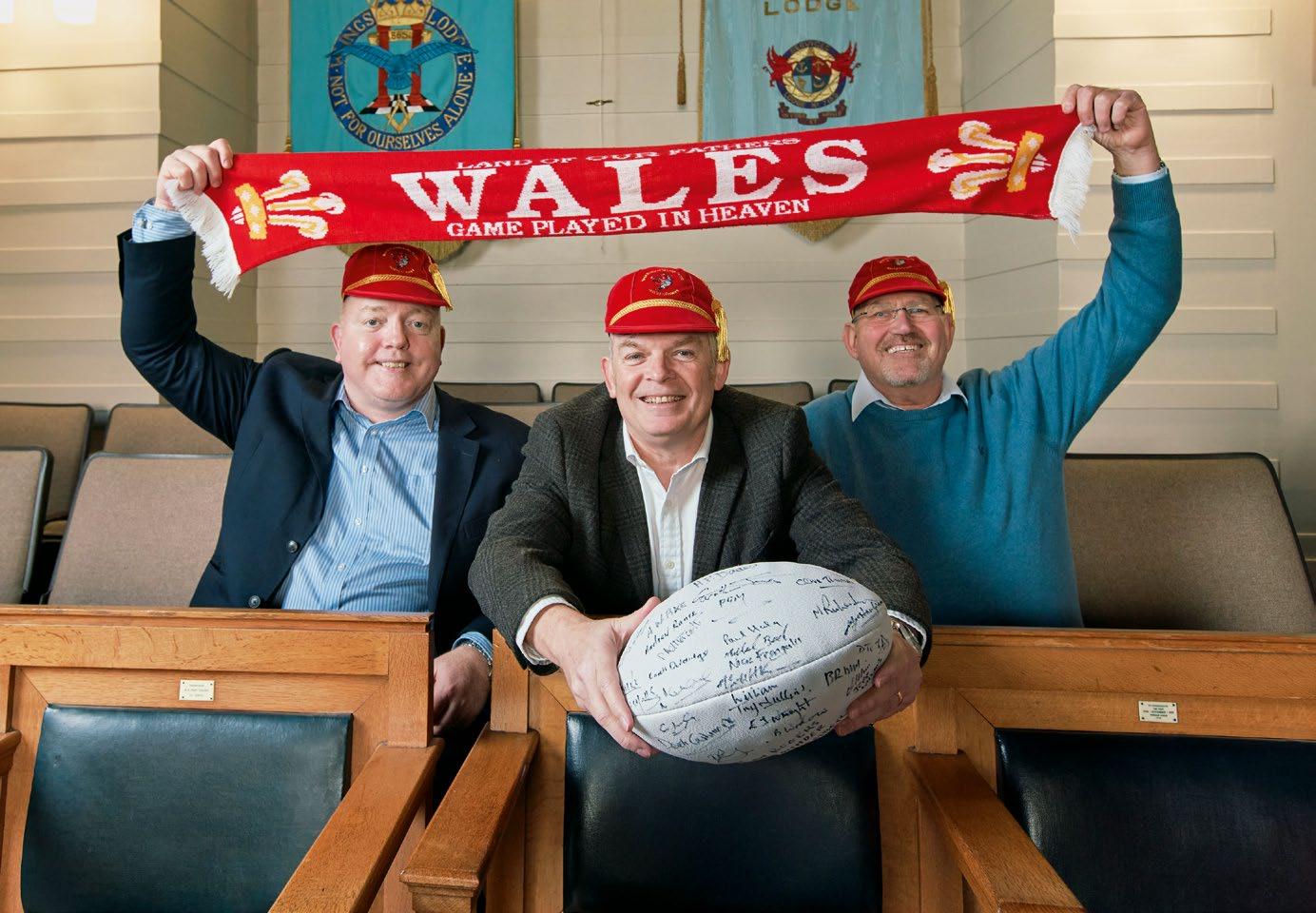
7 minute read
In the scrum
Boosted by the support of the Welsh national team, a group of rugby-playing Freemasons have formed the first rugby lodge in South Wales. Peter Watts joins the scrum
Doing it for the kicks
After standing shoulder to shoulder for many years in the scrum for Barry Rugby Football Club, Paul Haley (hooker), Phillip Nethercott (second row/prop) and Clive Thomas (back row) are teaming up once more. This time, the three rugby-playing Freemasons are combining their two loves – rugby and Freemasonry – in the form of Wales’s first rugby lodge, Welsh Rugby Clubs Lodge, No. 9986.
It’s the brainchild of Paul, who came up with the idea after talking to some of his fellow Freemasons at a lodge meeting. ‘We started knocking the idea around,’ he says. ‘I wrote to the Provincial Grand Master, and he said if we could get 40 sponsoring founders he’d agree to it. I managed to do that in about three days. It’s crazy that we didn’t have one already, as rugby is deep in the culture of Wales, especially here in South Wales.’
‘Welsh Rugby Clubs Lodge is an exciting development for South Wales and takes its place as the 161st lodge in our Province,’ says Gareth Jones, the Provincial Grand Master for South Wales. ‘Freemasonry in partnership with our national game will prove hugely popular, and I am heartened to see that there will be ongoing support for grassroots mini rugby. I have no doubt that the impressive charitable contributions that have already been made will continue at pace. The advent of a new lodge is always a very special moment, and I look forward with great interest and enthusiasm to see what the founders and new members achieve together as a team during the coming years.’
Rugby is everywhere in this part of Wales. Even the new lodge’s base, Penarth Masonic Hall, is located on the site of the rugby ground where Penarth hosted Barbarians in much-anticipated Good Friday fixtures between 1890 and 1914. In recognition of this history, the lodge was consecrated at Cardiff Masonic Hall on 30 November 2019, the day Barbarians played Wales in Cardiff. In attendance were 170 Freemasons, including representatives from rugby lodges in England. It was a sign of the camaraderie that the new lodge hopes to bolster and draw upon in the years ahead. A first for Wales: (l to r, opposite page) Clive Thomas, Paul Haley and Phillip Nethercott combined their love of rugby and Freemasonry to form the new lodge
A bond that can bring people together The new lodge came together quickly. After making initial soundings around Christmas 2018, a meeting was held in February 2019 to see who was, in Paul’s words, ‘in it for the long haul’. A central team came together, many of whom were former rugby players, including several of Paul’s old Barry teammates. ‘Some have played at a really high level, and others are “raggedy bum rovers thirds,”’ he says. ‘We decided that all of our charitable work will support grassroots rugby. We had a dinner with Graham Price, who played for the famous Wales national team in the ’70s, and that inspired more people to get involved.’
Paul thinks rugby and Freemasonry share some commonalities. ‘Both are very much about the team working together to achieve results,’ he says. ‘There’s a sporting attitude to rugby. It’s about beating your opponent on the pitch but being friendly once the game is over. That camaraderie with the players around you – even the ones on the opposing side – is something that connects with Freemasonry. ‘There’s real cross-pollination between the two, and we want to encourage children to play rugby,

where there is greater respect for other players and the referee than other sports. We think Freemasonry fits with that idea of bringing people up in a respectful, friendly team environment. Hopefully one day they will grow up to be Freemasons.’
The rugby theme has already attracted attention. At a fundraising dinner where Phil Steele, a former Newport player and TV presenter, gave a talk, there were more non-Freemasons than Freemasons in attendance. To capitalise on this interest, social events will be open to everybody. ‘Rugby is a bond that can bring people together,’ Paul says. There have also already been new recruits as a result of the lodge. In February, three new Freemasons were due to be initiated, with two more in March. ‘The idea of it being the rugby lodge has been the trigger to get them involved,’ says Clive, Senior Warden for the new lodge. ‘It has revitalised existing Freemasons and encouraged new Freemasons to join.’
Both initiations will take place the evening before Wales play international fixtures, and all lodge meetings are scheduled to precede Six Nations fixtures and autumn internationals. On each occasion, the Festive Board will be themed to match Wales’s opponents, with national flags on display. It’s hoped that opposing fans who are Freemasons will attend the ceremony before the game.
Rugby touches in every detail The rugby theme extends to details such as the rugby ball-shaped gavels made for the lodge by Michael Buck, a Freemason and carpenter. There are also rugby caps for lodge members, a rugby ball signed by the founders, and plans for a tie featuring the lodge logo – a cartoon red dragon carrying a rugby ball and wearing an apron with the club motto: ‘Passing It Forward’.
The unorthodox logo demonstrates the sense of fun within the lodge, but even this has a serious intent. The lodge’s charitable undertakings will raise funds for grassroots rugby, and some of the teams that have received donations have requested permission to use the lodge logo on their shirts. Fundraising activities are boosted by the support of the Welsh Rugby Union, the organisation that oversees Welsh rugby, which has given raffle prizes. And Wales’s Rugby World Cup team even recorded a message of congratulations for the lodge’s consecration ceremony.
‘Paul had a white screen for the Festive Board, and I began to canvass Welsh rugby players to give us a message. I eventually got a clip from the Welsh squad wishing us all the best,’ says Phillip. ‘I started working on them before the World Cup and kept sending emails until somebody eventually replied. I told them that we were raising money for Welsh rugby and that the more people enjoyed the day the more we could raise for grassroots rugby. The Welsh



‘Passing It Forward’: South Wales Provincial Grand Master Gareth Jones (top photo, opposite) consecrated the new lodge, whose charitable work will support grassroots rugby

Rugby Union seem keen because we are genuinely trying to support grassroots rugby.’
During planning sessions, Paul took note of what the various existing English rugby lodges were doing, hoping to amalgamate some of their best ideas. There are a dozen such lodges, including William Webb Ellis Lodge, No. 9740, in Warwickshire; Rugby Bastion Lodge, No. 9896, in Hampshire & Isle Of Wight; Spirit of Rugby Lodge, No. 9910, in Durham; Spirit of Rugby Lodge, No. 9922, in East Kent; Lodge of XV, No. 9944, in Essex; Ruck and Maul Lodge, No. 9974, in Oxfordshire; Rugby Football Lodge, No. 9811, in Yorkshire, West Riding; and Adrian Davies Lodge of Rugby Union, No. 9884, in Gloucestershire. Representatives from these lodges attended the consecration of Welsh Rugby Clubs Lodge, and the Welsh lodge will attend the consecration of Union of Rugby Lodge, No. 9989, in Leicestershire & Rutland in April. The English lodges already play occasional fixtures against each other, and this is something else Paul and his team have an eye on.
‘The main thing we will do after the initiation ceremonies is create a Welsh Freemasons rugby team,’ Paul says. ‘I told the guys from Leicester: “You can play your inter-Province cup, but we are not a Province, we are a nation.” That will be fun, and that has legs.
‘Who knows where we could be in five or 10 years? We could have games at Cardiff Arms Park in front of a few thousand people. When you go back 20 or 30 years, the Army versus Navy and Oxford versus Cambridge matches only got a few thousand, but now they are filling Twickenham. If you manage it right, it can become much bigger.’
It sounds very much as if Barry’s old scrum heroes could be ready to fold up their aprons, wash out their mouthguards and get back on to the pitch.










